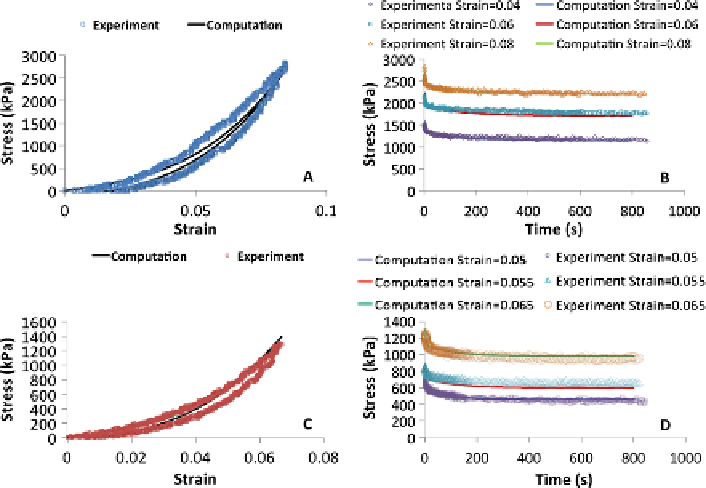Biomedical Engineering Reference
In-Depth Information
Fig. 25.7
Experimental response of native ACL (
A
)and(
B
)andBLB(
C
)and(
D
), and the com-
putational predictions using the 3D micromechanical viscoelastic model
analysis also serves as an important tool to characterize the ACL graft locally to
evaluate if it fully develops to match the biomechanical response of native ACL.
The similar functionally graded strain pattern that our tissue engineered BLB has
developed indicates its great potential to be used as the ACL graft (Fig.
25.6
).
Previously we have developed a three-element viscoelastic model (Ma et al.,
2010), for describing ligament and tendon response. This simple model qualitatively
captured the nonlinear viscoelastic responses of ligaments and tendons. Experimen-
tal data from stress relaxation experiments demonstrate that these soft tissues pos-
sess a bi-linear relaxation pattern. This finding is in agreement with the results from
collagen related research done by Shen et al. (
2011
) and Yang et al. (
2012
). There-
fore, we added another linear series spring-dashpot system to the existing model as
this two time constant feature fits the data well as seen in Fig.
25.3
. The nonlin-
ear strain-dependent viscoelastic responses of ligaments and tendons are captured
by the nonlinear MacKintosh network representing the collagen components of the
structure.
Our previous study shows the tissue engineered BLB, after 9 months of in vivo
recovery, has developed a similar microstructure to that of the native ACL as indi-
cated from longitudinally and sectionally stained tissue samples for both collagen
and elastin (Ma et al.,
2012b
). Vascularization and innervation are also developed in
these engineered BLBs and provide nutrition from the host body to further mature
the engineered BLBs in vivo. The tangent modulus of the engineered BLB attains
52 % of that of the contralateral ACL. The parameters of our microstructural consti-

